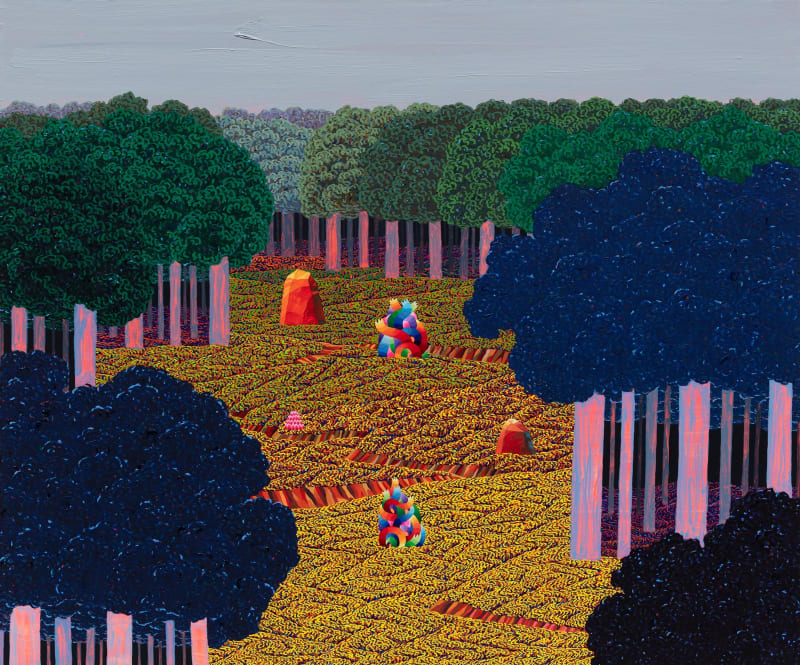White Drawing
Ahn Doojin (artist)
There was a time when both painting and the act of drawing were purely beautiful. Over the long course of artistic creation, singular protagonists, singular narratives, singular writings, and singular drawings have all dispersed like fleeting recollections, becoming memories that aid today's artistic elements-images. Alongside this timeless novelty, the hesitations of contemporaries summon these memories ceaselessly, positioning them at the very moment of 'drawing.' This exhibition begins from that very 'moment of drawing.'
Drawing as Thought
A painter's work is always in crisis-not because there is nothing left to paint, no new methods, or no adversaries to challenge, but because they have come to realize that "nothing is predetermined." In other words, the painter's crisis does not stem from the subject matter or medium of painting but rather from the very act of drawing as a mode of thought. Thought does not immediately determine affirmation or negation; instead, it refers to concealed philology, hidden traditions, the unthought, and remnants-posing questions to contemporaries. When an artist, as a contemporary being, suspends decisions through imagination, it is not merely a battle against grand narratives within the chronological artistic system but also a faint yet persistent struggle against excessive history and institutional constraints-a small flicker, a resistance. This is also a deferral of the desire to imitate intermediaries in a society of total commodification, where artists are expected to constantly produce novelty. Thus, contemporaneity is not the assimilation that arises from temporal gaps born of forgetfulness. Instead, it emerges through the montage of multiple events-manifesting and vanishing in the overlapping repetitions of disparate temporalities. The imagination that resists chronological time and traces back through entangled layers of temporality is montage-like thinking-drawing as thought.
Flickering Images
Thinking through drawing simultaneously engages thought and action upon a material space. It entails discovering an image's space, contemplating the image as material, and following the image as an act of thought. According to Georges Didi-Huberman, an image is not merely an object but an action and a process. Whether in film, photography, or painting, images are inherently inseparable from the acts of selection and editing that generate them. Images are not distinct from imagination but are instead divided internally and externally by frames, enacting a dialectical movement between concealment and revelation. This dialectical motion of the image-as an act-operates semiotically, flickering across the boundaries of the frame and thought, sustaining imagination. If this flickering movement of images in action aligns with thought, then the precise translation of this concept would be "drawing." When Jacques Rancière argues that images serve multiple functions and that art involves structuring these functions into problematics, drawing signifies the function of the image as a cognitive act.
White Drawing: On Traces
When drawing as thought flickers within a frame, the simultaneity of action and thought leaves traces (brushstrokes). A trace, by its nature, presupposes action and manifests as a material space. From the continuity of material space, sensation emerges-precisely because traces (brushstrokes) operate between two conflicting tendencies. One tendency is the trace as narrative-the trace of addition. Walter Benjamin compared this to the imprint of a potter's hand. Just as storytellers perpetuate narratives through continuous additions, even a single accidental brushstroke retains materiality and continuity, sustaining the inertia of relational extensions. These traces wrench the everyday embedded deep within thought into a rough, formless state. As the act of leaving traces is repeated, these brushstrokes overflow, either approaching figuration or consciously directing themselves toward the medium. The other tendency is the chronological trace-the trace of removal. This relates to what Gilles Deleuze, in The Logic of Sensation, describes as the "pre-existing representational givens." Painters struggle against these givens-Paul Cézanne called them "clichés" and sought to erase them. Chronological traces eliminate their subjects but add new layers of erasure, continually calling forth what was removed. Édouard Manet did not restore what he erased; instead, he introduced new methods of removal, persistently summoning the erased subjects. Thus, the chronological trace within a brushstroke is a scar, endlessly separated and re-removed from the historical traces of painting.
Consequently, white drawing embodies the simultaneous contradiction of two opposing traces. The dual nature of addition and removal maintains a paradoxical unity, connecting traces to one another. When drawing as thought flickers within the frame and traces shuttle between thought and material, the painter's struggle oscillates within each brushstroke between (+) and (-). This is neither a matter of representation versus anti-representation nor figuration versus abstraction; rather, it concerns how images as acts materialize through the painter.
When a painter confronts the canvas, brushstrokes navigate between purpose and method. From a critical perspective, the resulting work might seem to favor one side, but in the "here and now" where traces emerge, no single choice has truly been made. This is only natural; in fact, a decisive assertion that "it has been determined, and so it must be" would be far more unnatural. When a painter recognizes the three-dimensionality of drawing itself, rather than drawing for an overarching purpose, they can confront their own desire to imitate and resist the imposed role of the epic protagonist. The painter neither approaches their craft for narrative nor commits solely to representation. Instead, they both draw and do not draw the place they seek to depict-equating surface materiality with internal force, subverting viewer expectations, evoking the layered thickness of historical sentiment from a contemporary expressionless face, and rejecting the total commodification of art by employing fragmented rather than tragic language. It is only natural, then, that a painter's work is often difficult to comprehend. The artist paints the subject, yet simultaneously recalls past memories through it; they depict a place, yet dissolve into its space. They keep the audience waiting indefinitely, leading them astray. They deny affirmation to what is peculiar, recognizable, and consumable, dismantling the expectation that the painter should 'speak' or 'show.' The painter's work resembles boarding a bus with no known route-when expectations crumble, and resignation sets in, perhaps that is precisely when the fleeting moments of happiness arrive. "Only sometimes."

